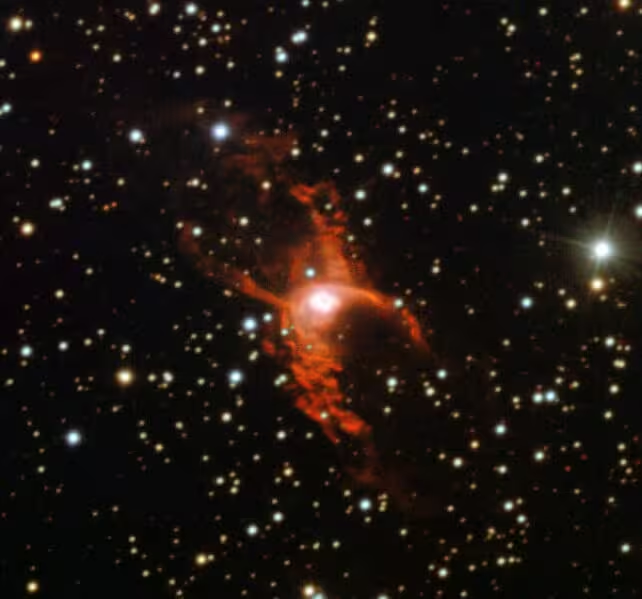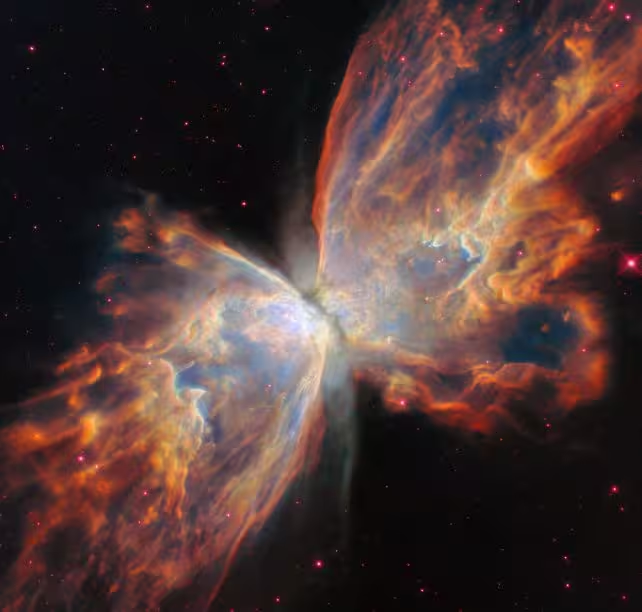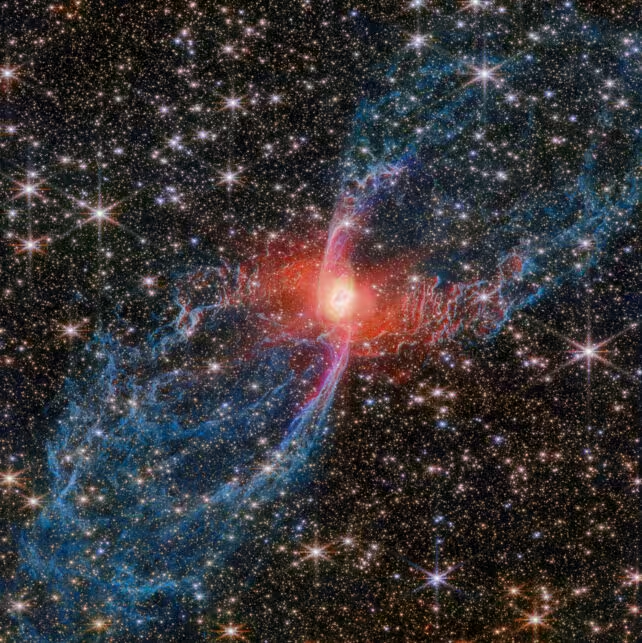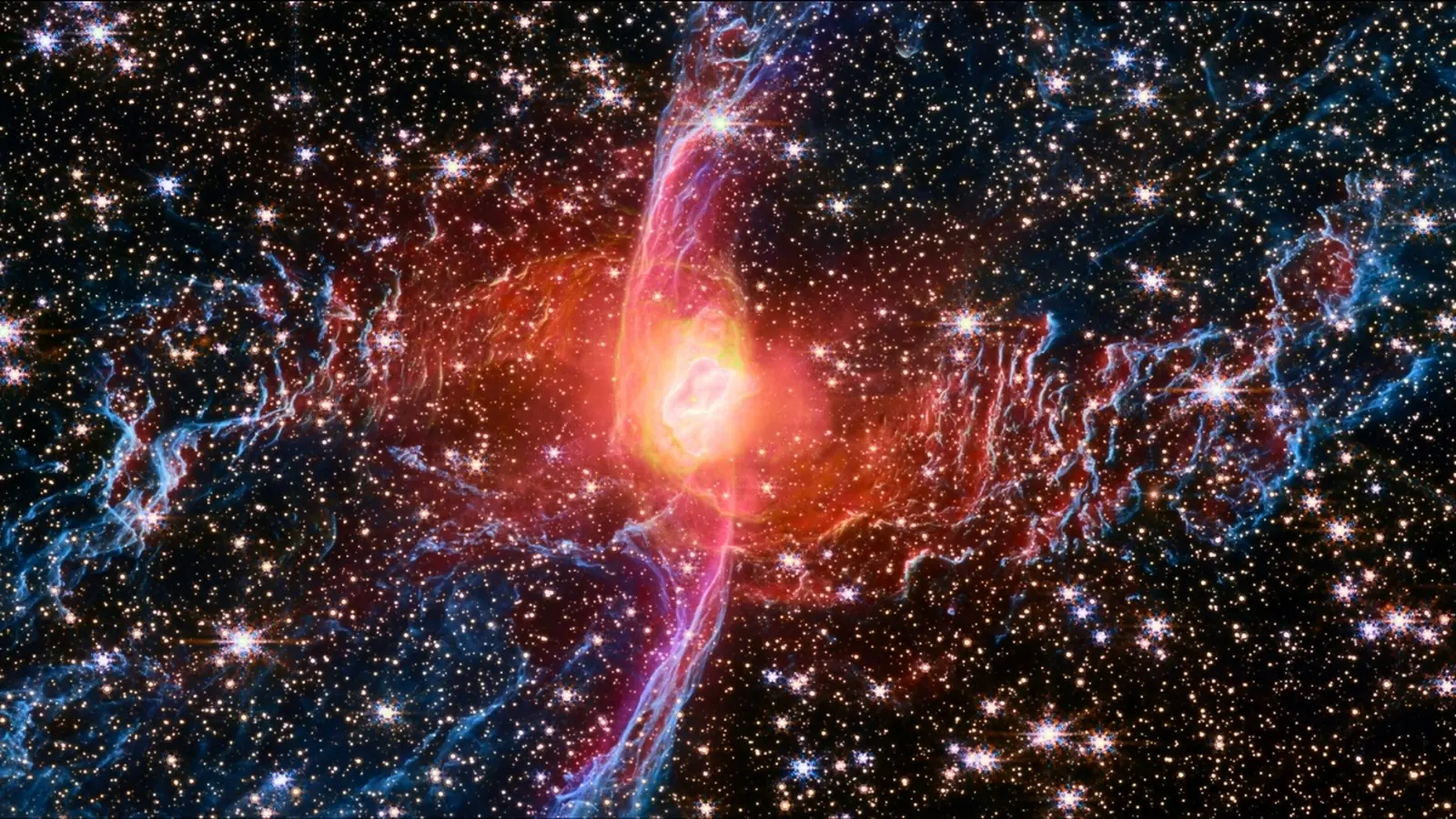5 Minutes
New infrared images from the James Webb Space Telescope have peeled back layers of dust and gas around NGC 6537, the so-called Red Spider Nebula, exposing an energetic core and revealing structures that hint at a secret companion shaping the dying star's last breaths.
Infrared vision reveals a smoldering core
NGC 6537 is catalogued as a planetary nebula — a misnomer dating to early telescopes, since these objects have nothing to do with planets. They form when Sun-like stars exhaust nuclear fuel, expand into red giants and ultimately eject their outer layers. The exposed hot core bathes the ejected gas in ultraviolet light, making the shell glow for a relatively brief window of a few tens of thousands of years.
Webb's Near InfraRed Camera (NIRCam) shifts the view from optical to infrared, where cool dust and warm gas appear bright. Where Hubble saw only a faint blue central star, Webb detects a red, dust-enshrouded source — consistent with a compact disc of hot dust orbiting the central stellar remnant. That dust disc blazes in infrared wavelengths even as it remains invisible to optical telescopes.
A hidden sculptor: clues for a binary companion
The nebula's dramatic hourglass or bipolar shape — a narrow waist flanked by wide lobes — is a strong morphological clue that a second star may be present. Binary companions can torque and redirect outflowing gas, carving pinched waists and symmetrical lobes. Examples include the well-known Butterfly Nebula, where a companion and a band of dense dust together outline a striking silhouette.
In NGC 6537, only one star is directly visible, but the geometry and the presence of fast, collimated jets strongly suggest a partner lurking close to the core. Those jets, traced by emission from ionized iron, form an elongated purple 'S' in Webb images and slam into earlier, slower ejecta — sculpting ripples and shock fronts that are now visible across the nebula.

This image shows the bipolar planetary nebula, NGC 6537 taken with the New Technology Telescope at ESO's La Silla Observatory. (ESO)
Sprawling legs mapped by molecular hydrogen
Perhaps the most striking discovery is the nebula's vast 'legs' — bubble-like lobes extending roughly three light-years each. Webb's wide field captured these full structures for the first time, and the lobes are traced by molecular hydrogen: pairs of hydrogen atoms bound together and glowing in the infrared. Rendered in blue in the composite images, these closed bubbles appear inflated by thousands of years of sustained outflow from the dying star.
Those molecular hydrogen features record a history of mass loss and interaction, showing where slow, dense shells met faster, more recent winds and jets. The result: an intricate, multi-layered shell that preserves the star's late-stage behavior.

Hubble Space Telescope image of the Butterfly Nebula in optical wavelengths. You can see the thick band of dark dust in the center. (ESA/Webb, NASA & CSA, K. Noll, J. Kastner, M. Zamani/CC BY 4.0)
Why these observations matter
Studying objects like NGC 6537 helps astronomers read the final chapters of stellar evolution. The interplay of discs, jets, and binary interactions determines the nebula's shape and the way material returns enriched elements to the interstellar medium. Webb's sensitivity to dust and molecules provides a more complete physical picture than optical images alone.
These observations are part of a program led by J. Kastner that investigates how bipolar planetary nebulae acquire their forms through directed outflows and jet activity. By combining infrared imaging with spectroscopic follow-up, researchers can measure velocities, composition and temperature — key ingredients to model the mechanics of the shaping process.

This new NASA/ESA/CSA James Webb Space Telescope Picture of the Month features NGC 6537 – the Red Spider Nebula. Using its Near InfraRed Camera (NIRCam), Webb has revealed never before seen details in this picturesque planetary nebula with a rich backdrop of thousands of stars (NASA/ESA/CSA)
Implications for the future of our Sun
While the Sun will not produce a nebula identical to NGC 6537, the mechanisms at work — envelope ejection, dust formation, and the shaping influence of companions and jets — are the processes that will ultimately dictate our star's final visible form billions of years from now. Webb's images offer a clearer preview of those distant outcomes and a sharper window into the physics of dying stars.
Source: sciencealert
Comments
atomwave
Is that companion for real or just a dusty illusion? Looks like jets slam into shells, but i'd want velocity maps first, show me the numbers
labcore
wow the Red Spider looks haunted... Webb peels back layers and suddenly there's a whole drama in the core. hidden companion? gives me chills, ngl


Leave a Comment